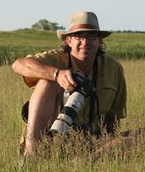On the morning of our final full day on Hog Island, everyone at the camp embarked on the camp's large boat, the Puffin V for a cruise out to Eastern Egg Rock. Eastern Egg Rock is where Stephen Kress and his colleagues at National Audubon began the very successful reintroduction of the Atlantic puffin to Maine's coastal islands. At the time, there were only two small nesting colonies of Atlantic puffins in the U.S.--both off the Maine coast and both threatened by predation, harsh weather, and ever-growing gull populations.
When Project Puffin started, in 1973, it was based out of Hog Island, where Steve Kress had spent many summers as a camp instructor and director. Puffin chicks were collected from wild nests in Newfoundland were brought in tube-filled boxes to Hog Island, then placed in artificial burrows on Eastern Egg Rock. You can still see these puffin transport boxes in the Fish House on Hog Island.
The reintroduction effort was eventually a success, but there were many problems along the way. Chief among these is the clear fact that, for puffins and other rare nesting seabirds on these islands, survival relies on constant human surveillance and control of predators. Without both of these, the puffins, terns, and storm petrels nesting on Eastern Egg Rock and the other islands nearby would be gobbled up by gulls and other predators--both natural and introduced.
I'd made the puffin pilgrimage back in the late 1980s, taking the ferry out of Jonesport, Maine to Machias Seal Island. On that trip we all disembarked and spent hours in a puffin monitoring blind. No such adventure on this trip. Eastern Egg Rock has a handful of volunteer monitors on it, but it's too disturbing for the nesting birds for 30 birders to come ashore. So we'd have to be content with watching the birds from the very stable decks of the Puffin V.
Julie was in high spirits as we cruised out toward Eastern Egg Rock, taking pictures like a crazy person. We knew we'd see puffins, but for Julie and several others on board, the anticipation of seeing a life bird as glamorous as the "sea toucan" was almost too much to bear.
We cruised outbound for a couple of hours, seeing many picturesque islands, rocky shoals, and many, many birds. Among the common terns were a few roseates and the occasional Arctic.
Lighthouses still stand on several of the islands, though none is tended by a lighthouse keeper anymore, this being the computer age. It's impossible to resist taking photographs of a lighthouse--even when the daylight is harsh and the boat is rocking.
And then, we saw them. Just tiny, black footballs whirring over the waves--PUFFINS!
That bill! I'm not sure what the purpose of such a large, laterally flattened bill is and I don;t really care. This is one of those totem birds that you see in the field guide and say to yourself: "Someday I'd like to see THAT bird!"
Jen Sauter, our Ohio birding pal, and Julie compare puffin photos. This was a life bird for both gals.
If you've never seen an Atlantic puffin, this is a great way to do it. Our co-leaders (and longtime Hog Island instructors) Mike Shannon and Tom Leckey filled our brains with fascinating natural history information about the islands, the creatures, the ocean. For more information about Maine Audubon's regular puffin-watching cruises, waddle on over to here.
What a day! The sun was out, the sea was calm, the wind was gentle, the company was good, and, as we cruised back to Hog Island, we had visions of puffins dancing about in our heads.






4 comments:
That is exactly what I thought to myself the first time I saw puffins in my first field guide...'I want to see one of THOSE someday!'
Had to go to Scotland to see this one as well.
Life bird for Anne and me.
We literally saw One puffin.
Wow, what a neat story and great pictures! Is that the only area to see puffins in the continental United States?
Thanks for sharing.
Eew--what does a seabird colony smell like? Doesn't sound good...
Post a Comment